 |
 |
|
 |
 |
Light metering Through The Lens:
While the 40's and the 50's was a pioneer time when the PP SLR slowly started to take over as the favourite camera of the pros, the 60's became a time for new technical improvements, especially for light metering. The East-German Pentacons selenium meter from '56 was a step ahead for its time, but the weakness of these meters was that they only measured the general light, not the light reflected from the subject. Already the first year of the new decennium, in 1960, Asahi Pentax shocked the world by presenting a prototype of their Spot-Matic, a camera that measured the light through the lens - TTL - with Cadmium sulfide Cells (CdS). The others were still struggling with their selenium based meters. However, Asahi kept the world waiting before they would produce it..
Asahi Pentax Spotmatic - as it came to appear. First shown at Photokina in 1960, in production from 1964.
Asahi Pentax Spotmatic - as it came to appear. First shown at Photokina in 1960, in production from 1964.
Pentax really was on the move. Even though they were to show their Spot-Matic at Fotokina the same year, they kept the initiative by presenting an external light meter based on CdS, measuring the light through a small hole directed against the subject. The light meter was placed on top of the prism house. The first camera constructed for this was the S3 in 1960. My sample shown here has sn. 512706.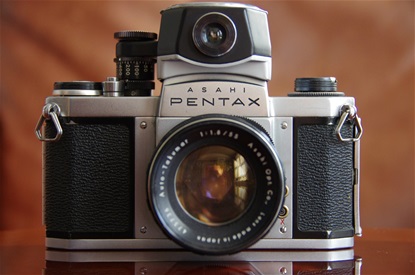
Pentax really was on the move. Even though they were to show their Spot-Matic at Fotokina the same year, they kept the initiative by presenting an external light meter based on CdS, measuring the light through a small hole directed against the subject. The light meter was placed on top of the prism house. The first camera constructed for this was the S3 in 1960. My sample shown here has sn. 512706.
Asahi Pentax Meter had a scale were an arrow showed the suggested aperture based on given ASA and shutter time. The shutter dial on the meter was linked to the dial on the camera. The meter had two modes, High light and Low light. My meter has sn. 197119.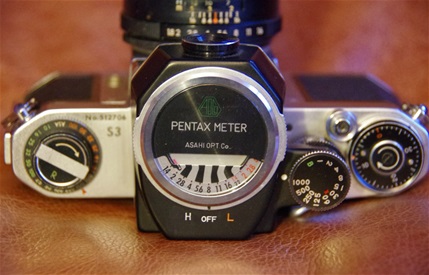
Asahi Pentax Meter had a scale were an arrow showed the suggested aperture based on given ASA and shutter time. The shutter dial on the meter was linked to the dial on the camera. The meter had two modes, High light and Low light. My meter has sn. 197119.
Minolta was the first to put the CdS meter inside the camera, placed in the upper left front. Pro: built-in was better than external gadgets. Con: not as direct on the subject as the Pentax (center) or Nikon (slightly right) meters. Sn. 2424035.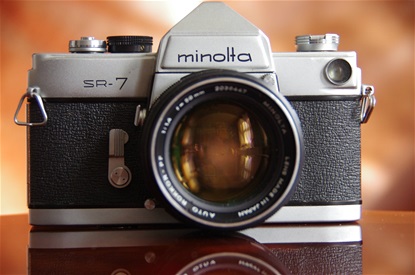
Minolta was the first to put the CdS meter inside the camera, placed in the upper left front. Pro: built-in was better than external gadgets. Con: not as direct on the subject as the Pentax (center) or Nikon (slightly right) meters. Sn. 2424035.
In the window by the rewinder you get the aperture values when pushing the button right behind. 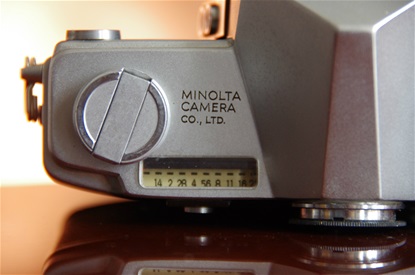
In the window by the rewinder you get the aperture values when pushing the button right behind.
Nikon F was launched in '59, with interchangable finder, but without light metering. A finder with CdS metering through was introduced in 1962, called Photomic.a small window, In addition, there was a mechanical transfer from the Photomic prism to the aperture ring on the lens. Sn. 6474001.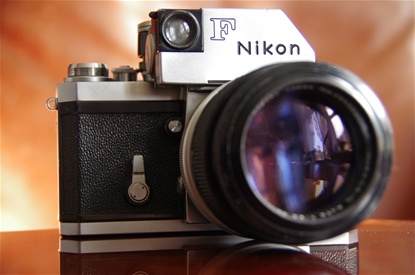
Nikon F was launched in '59, with interchangable finder, but without light metering. A finder with CdS metering through was introduced in 1962, called Photomic.a small window, In addition, there was a mechanical transfer from the Photomic prism to the aperture ring on the lens. Sn. 6474001.
Although big and clumsy, the F Photomic soon was very popular among the pros. The controls were as usual, but the speed dial was on top of the prism with its movements transferred to the dial of the camera, as on Pentax Meter. In addition, one had to make sure the lens was properly mounted with the pin from the Photomic being caught by the claw on the lens. In 1965 the first Nikon F Photomic T was launched with Nikons first TTL metering.
Although big and clumsy, the F Photomic soon was very popular among the pros. The controls were as usual, but the speed dial was on top of the prism with its movements transferred to the dial of the camera, as on Pentax Meter. In addition, one had to make sure the lens was properly mounted with the pin from the Photomic being caught by the claw on the lens. In 1965 the first Nikon F Photomic T was launched with Nikons first TTL metering.
While Pentax was spending time to find the right solution for their new baby shown in '60, Topcon came up with their system in time to be number one on the market. The first production TTL SLR was sold in '63, and named Topcon RE Super. Their system was a bit different from Asahis. RE Super featured a metering at full aperture opening, it had an interchangable finder and presented a variety of lenses and extras. Sn. 4603773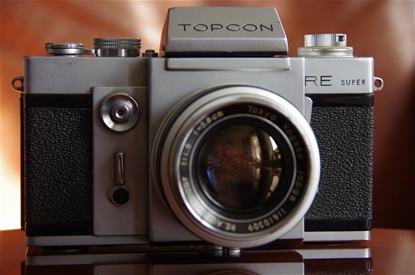
While Pentax was spending time to find the right solution for their new baby shown in '60, Topcon came up with their system in time to be number one on the market. The first production TTL SLR was sold in '63, and named Topcon RE Super. Their system was a bit different from Asahis. RE Super featured a metering at full aperture opening, it had an interchangable finder and presented a variety of lenses and extras. Sn. 4603773
Topcon made quality cameras, but the design was a bit edgy and not so attractive. In spite of the fact that Topcon was at ahead technologically, most pros chose Nikon. While the masses were waiting for Pentax...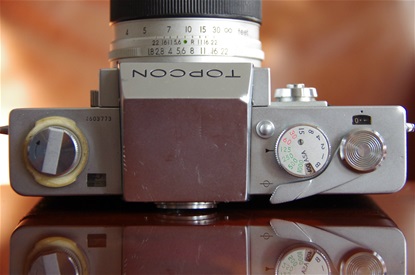
Topcon made quality cameras, but the design was a bit edgy and not so attractive. In spite of the fact that Topcon was at ahead technologically, most pros chose Nikon. While the masses were waiting for Pentax...
1964: Asahi Pentax Spotmatic:
Even though four years should pass from the introduction in 1960 till the Spotmatic was produced for sale, only Topcon came ahead of them. But when it came, it was to be one of the greatest successes of camera history. One of the reasons for its taking time, was the choice of metering system. The prototype had spot metering, hence the name Spot-Matic, but Asahi technicians came to doubt whether it would be the best for the average amateur photographers, which was always a target group for Asahi. Tests showed them that center weighed average metering would be more helpful to the average user. So, in the end, that's what they chose. More about the Spotmatic success under Pentax' history. Sn. 2569816.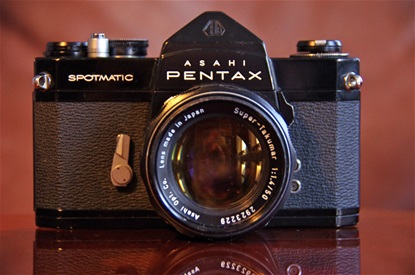
Even though four years should pass from the introduction in 1960 till the Spotmatic was produced for sale, only Topcon came ahead of them. But when it came, it was to be one of the greatest successes of camera history. One of the reasons for its taking time, was the choice of metering system. The prototype had spot metering, hence the name Spot-Matic, but Asahi technicians came to doubt whether it would be the best for the average amateur photographers, which was always a target group for Asahi. Tests showed them that center weighed average metering would be more helpful to the average user. So, in the end, that's what they chose. More about the Spotmatic success under Pentax' history. Sn. 2569816.
Pentaxian style, of course. Sn. on top plate, with model name shortened to SP. On the front of the camera there was a button that had to be pushed up when metering. Time or aperture then had to be adjusted until the needle in the viewer found its position between + and -. 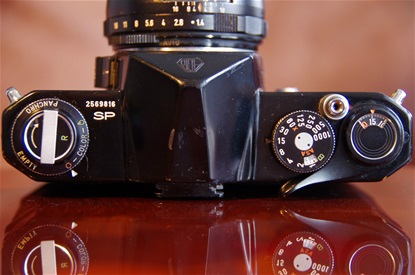
Pentaxian style, of course. Sn. on top plate, with model name shortened to SP. On the front of the camera there was a button that had to be pushed up when metering. Time or aperture then had to be adjusted until the needle in the viewer found its position between + and -.
1964: Soviet Union: Arsenal Kiev 10 Automat:
The Arsenal factory of Kiev, Ukraine, Soviet Union, released this camera in 1964, two years before the Konica Autorex (Autoreflex in the US), thus being the first PP SLR to offer authomatic aperture when choosing shutter speed. (The Konica is usually given the credit.) Both cameras had an external metering, Kiev with a selenium meter, Konica with a more modern CdS. The Kiev 10 Automat was certainly not like everybody else! More details under Lost Brands: the 90's.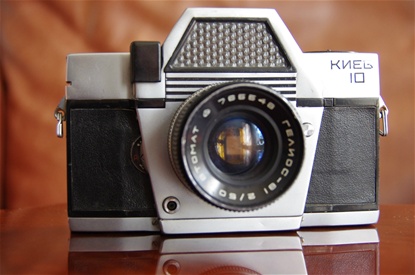
The Arsenal factory of Kiev, Ukraine, Soviet Union, released this camera in 1964, two years before the Konica Autorex (Autoreflex in the US), thus being the first PP SLR to offer authomatic aperture when choosing shutter speed. (The Konica is usually given the credit.) Both cameras had an external metering, Kiev with a selenium meter, Konica with a more modern CdS. The Kiev 10 Automat was certainly not like everybody else! More details under Lost Brands: the 90's.
A Helios 81 50/2 Automat lens.
Sn: 766548.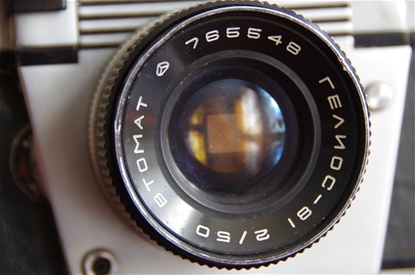
A Helios 81 50/2 Automat lens.
Sn: 766548.
A radical design: No winder on top, shutter release button in front, but operated from the top, shutter speed dial to the left. This was inherited from the Zunow design of 1958, giving a faster fingertip handling, and was taken up by Canon in the late 70's.
More about the Kiev under Lost Brands :the 90's. 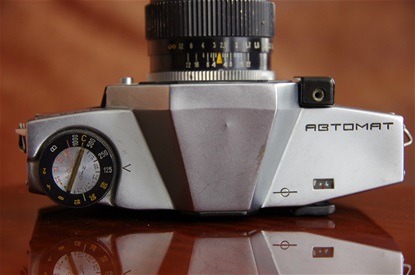
A radical design: No winder on top, shutter release button in front, but operated from the top, shutter speed dial to the left. This was inherited from the Zunow design of 1958, giving a faster fingertip handling, and was taken up by Canon in the late 70's.
More about the Kiev under Lost Brands :the 90's.
1964: Soviet Union: Zenit 5:
1964 really meant a breakthrough for Soviet Union camera engineering as, in addition to the automatic Kiev, KMZ introduced worlds first built in motor SLR camera. Inspired by the West German Voigtlander Bessamatics light metering, this camera featured a similar system and a leaf shutter. The lens was interchangeable. Sn. camera: 6602564. Sn. lens: 24569.
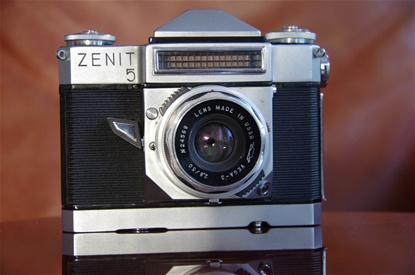
1964 really meant a breakthrough for Soviet Union camera engineering as, in addition to the automatic Kiev, KMZ introduced worlds first built in motor SLR camera. Inspired by the West German Voigtlander Bessamatics light metering, this camera featured a similar system and a leaf shutter. The lens was interchangeable. Sn. camera: 6602564. Sn. lens: 24569.
Shutter release button on front wall, winder knob to the right, not very fast, so the built in winder comes in handy. Interchangeable finder. ASA/DIN settings on the inner scale of the dial to the left. This dial also sets correct values according to the matching arrow/ring seen in the finder.
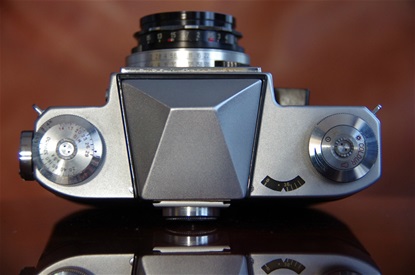
Shutter release button on front wall, winder knob to the right, not very fast, so the built in winder comes in handy. Interchangeable finder. ASA/DIN settings on the inner scale of the dial to the left. This dial also sets correct values according to the matching arrow/ring seen in the finder.
Minolta SRT 101 became popular, metering TTL at full opening. Still it was among the many to hit the shadow of Spotmatic. Minolta called their metering system CLC - Contrast Light Compensation. This system measured the contrasts in the subject with a center weighed meter. Minolta claimed this to be better than both average and spot metering.
Sn. 2533115.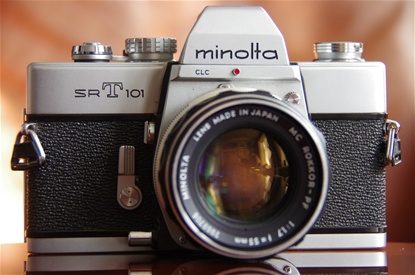
Minolta SRT 101 became popular, metering TTL at full opening. Still it was among the many to hit the shadow of Spotmatic. Minolta called their metering system CLC - Contrast Light Compensation. This system measured the contrasts in the subject with a center weighed meter. Minolta claimed this to be better than both average and spot metering.
Sn. 2533115.
Controls placed where one would like to find them. A very well made camera. 
Controls placed where one would like to find them. A very well made camera.
1968: Konica Autoreflex T:
Konica Autoreflex T was the first PP SLR camera with CdS TTL metering at full opening and automatic shutter priority. (Choose shutter time, camera selects aperture value.) It was a very popular camera. I bought mine (T2) in '72- 4 years after the debut, and it was still rather advanced. The metering covered the lower and central part of the subject, to reduce the impact of background light. This sample is in fact a T2, although that was never marked on the cameras. It differed from the T first of all by the on/off switch in front of the trigger. There were other small details, too, but no new features.
Sn. 122612. See more details on Konica at Lost Brands.
Konica Autoreflex T was the first PP SLR camera with CdS TTL metering at full opening and automatic shutter priority. (Choose shutter time, camera selects aperture value.) It was a very popular camera. I bought mine (T2) in '72- 4 years after the debut, and it was still rather advanced. The metering covered the lower and central part of the subject, to reduce the impact of background light. This sample is in fact a T2, although that was never marked on the cameras. It differed from the T first of all by the on/off switch in front of the trigger. There were other small details, too, but no new features.
Sn. 122612. See more details on Konica at Lost Brands.
A very Pentax-like layout. B-1/1000 shutter speed. Lens: Hexanon AR 52/1,8. Sn. 7805160.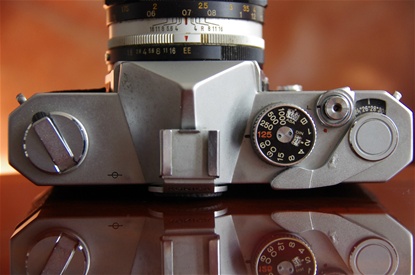
A very Pentax-like layout. B-1/1000 shutter speed. Lens: Hexanon AR 52/1,8. Sn. 7805160.
1968: Mamiya/Sekor 1000 DTL:
The camera producers had a hard time deciding which of the two, average or spot metering? Mamiya said: "Both, of course", and became the first producer to offer the choice. Sn. 625991. Lens is a Auto Mamiya/Sekor 50/1,4, sn. 202983.

The camera producers had a hard time deciding which of the two, average or spot metering? Mamiya said: "Both, of course", and became the first producer to offer the choice. Sn. 625991. Lens is a Auto Mamiya/Sekor 50/1,4, sn. 202983.
Pentaxian layout. The winder arm points a bit backwards. Push it forwards, and you see the depth of field. (DOF.)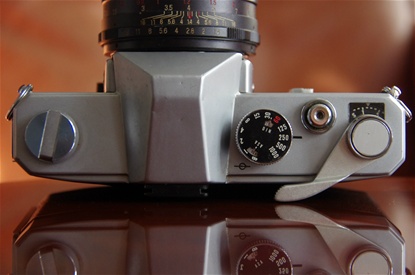
Pentaxian layout. The winder arm points a bit backwards. Push it forwards, and you see the depth of field. (DOF.)
To the left of the lens, under flash contacts, you find the S(spot)/A(average) switch.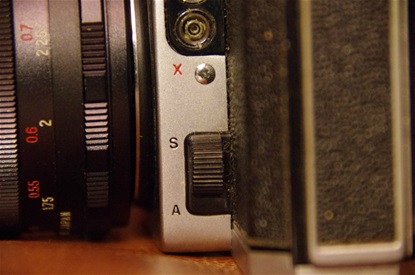
To the left of the lens, under flash contacts, you find the S(spot)/A(average) switch.
1969: Yashica TL Electro-X:
Yashica was the first camera with electronic light metering. A CdS meter (average) gave impulses via transistor circuit cards to red lamps in the viewer showing over/under exposure. The camera shown here is the TL Electro, a somewhat simplified version from 1972. Sn. 70301376.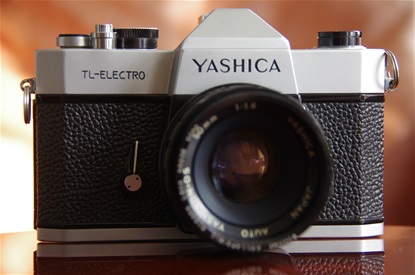
Yashica was the first camera with electronic light metering. A CdS meter (average) gave impulses via transistor circuit cards to red lamps in the viewer showing over/under exposure. The camera shown here is the TL Electro, a somewhat simplified version from 1972. Sn. 70301376.
Praktica was worlds first with electronically controlled shutter, and that even on their M 42 screw mount. Sn: 351814. Lens is Pentacon Electric Multi Coating 50/1,8 M 42. Sn. 7926039.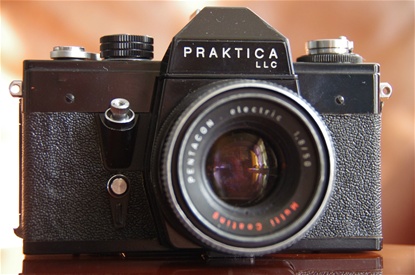
Praktica was worlds first with electronically controlled shutter, and that even on their M 42 screw mount. Sn: 351814. Lens is Pentacon Electric Multi Coating 50/1,8 M 42. Sn. 7926039.
Winder has a very short and effective travel with a smooth feeling.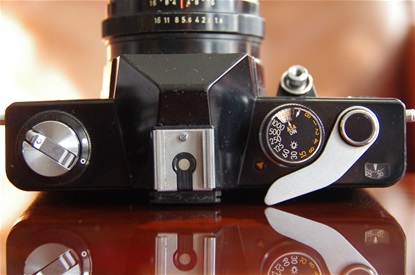
Winder has a very short and effective travel with a smooth feeling.
|
|
 |
|
|
|